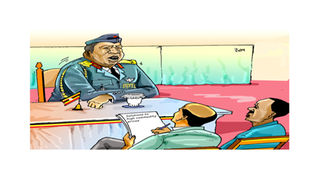
An illustration of former president Idi Amin meeting his officials. ILLUSTRATION /IVAN SENYONJO
|People & Power
Prime
How Amin reacted to soaring commodity prices in 1975
What you need to know:
- The statement issued by the government spokesperson warned that whoever was found selling at a higher price would be arrested and prosecuted according to the laws.
In 1974, as inflation in Uganda was beginning to hit the roof, the public demand an intervention from then president Idi Amin. They wanted prices of essential commodities reduced.
On January 22, 1975, Amin hosted a special meeting to remedy the situation. The meeting was attended by Cabinet ministers, governors, senior security and government officials, members of the Advisory Board of Trade and heads of parastatal bodies.
The meeting was held at Amin’s offices at the Parliament Building in Kampala. The meeting adopted a decision to fix prices of all commodities, including transport fares.
A press statement issued after the meeting revealed that governors and other senior government officials were to oversee the implementation of government intervention.
The statement said traders were required to clearly display the price of every commodity in their shops for their customers to see.
It was decided also that the Ministry of Commerce, in collaboration with the Advisory Board of Trade, would keep a watchful eye on errant traders.
The statement quotes Amin as having said of farmers: “President Amin said they used to say they were selling their products, particularly matooke, at exorbitant prices to the tune of Shs40 because they were buying a hoe at the cost of between Shs50 and Shs60 each. The government, he declared, had now set the price of a hoe at Shs10. He was, therefore, anxiously waiting to see a reduction on matooke prices from the farmer to the market.”
Amin wondered why, for example, a set of chairs cost Shs1,500 at Uganda Prisons yet it cost twice as much in Kampala shops yet they both used timber from Uganda and raw materials from the same countries.
“Government wanted to come out with a fair list of all prices because government did not want any business body to work on loses,” the statement read.
The meeting also decided that clearing of Ugandan imports at the Mombasa Port in Kenya would be done by Transocean, a government shipping, clearing and forwarding parastatal.
Amin said this would prevent some exiled Ugandans in Kenya who had formed a union and had started clearing and forwarding Ugandan imports.
“He said these people were not honest to Uganda. They had caused delays of imports and had made the government and businessmen lose a lot of money. These people were collaborating with imperialists and there were no reasons why they should clear our imports when government spends a lot of money in buying lorries [for Transocean] to forward our goods,” the statement read.
It added that during the meeting Amin urged Ugandans to become creative problem solvers.
“According to what he [Amin] had seen in other countries, Uganda was alright. But because people had never faced big problems, they kept on complaining about minor things, yet they should thank God who blessed their country with varied potentials,” the statement read.
During the meeting, it was revealed that some depots hoarded commodities and when managers were arrested, they claimed that the goods belonged to the armed forces.
The statement issued by the government spokesperson warned that whoever was found selling at a higher price would be arrested and prosecuted according to the laws.
But since there was no law to prosecute those engaged in hoarding at the time, President Amin immediately enacted the hoarding decree.
History ... Economic war...
In 1972, president Idi Amin declared `economic war’ against the large and comm-ercially dominant Asian community in Uganda.
This marked the beginning of an economic collapse and of escalating political and social disorder.
Amin intervention
Commodity Price Reduced by
1-Beans (1 colour) 80 20
2-Beans (White) 120 50
3-Beans (mixed) 70 20
4-Soya beans 110 30
5-castor seed 70 -
6-Dried chilies (large) 150 40
7-Dried chilies (small) 300 70
8-Finger millet 70 20
9-Gram flour (black) 90 20
10-Gram flour (green) 90 20
11-Gram flour (yellow) 90 20
12-G.nuts (shelled) 160 30
13-G.nuts (unshelled) 100 30
14-G.nuts roxo (shelled) 170 35
15-G.nuts roxo (unshelled) 110 35
16-Maize white 50 10
17-Maize pure white 75 15
18-Paddy rice (mixed) 60 15
19-Paddy rice (separated) 70 15
20-Paddy rice (bungala) 80 10
21-Paddy rice (sindano) 90 15
22-Cow peas 80 25
23-Piegeon peas 80 25
24-Dry field peas 90 25
25-Sim-Sim 180 50
26-Sorghum 35 10
27-Sunflower seed (mixed) 70 35
28-Sunflower seed (grey) 100 50
29-Sunflower seed (black) 80 30
30-Sunflower seed (white) 100 40
31-Wheat 100 35




